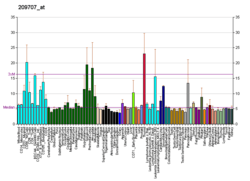PIGK
GPI-anchor transamidase is an enzyme that in humans is encoded by the PIGK gene.[5][6]
This gene encodes a member of the cysteine protease family C13 that is involved in glycosylphosphatidylinositol (GPI)-anchor biosynthesis. The GPI-anchor is a glycolipid found on many blood cells and serves to anchor proteins to the cell surface. This protein is a member of the multisubunit enzyme GPI transamidase and is thought to be its enzymatic component. GPI transamidase mediates GPI anchoring in the endoplasmic reticulum, by catalyzing the transfer of fully assembled GPI units to proteins.[6]
Interactions
PIGK has been shown to interact with PIGT[7] and GPAA1.[8][9]
gollark: Wait, school in late August? Madness.
gollark: My naming backlog has at last been cleared.
gollark: ***HATCH STUPID EGG***
gollark: There's a 4G from 4 alt omen wyrms up in the hub of despair.
gollark: How likely is that to actually work?
References
- GRCh38: Ensembl release 89: ENSG00000142892 - Ensembl, May 2017
- GRCm38: Ensembl release 89: ENSMUSG00000039047 - Ensembl, May 2017
- "Human PubMed Reference:". National Center for Biotechnology Information, U.S. National Library of Medicine.
- "Mouse PubMed Reference:". National Center for Biotechnology Information, U.S. National Library of Medicine.
- Yu J, Nagarajan S, Knez JJ, Udenfriend S, Chen R, Medof ME (December 1997). "The affected gene underlying the class K glycosylphosphatidylinositol (GPI) surface protein defect codes for the GPI transamidase". Proc Natl Acad Sci U S A. 94 (23): 12580–5. Bibcode:1997PNAS...9412580Y. doi:10.1073/pnas.94.23.12580. PMC 25045. PMID 9356492.
- "Entrez Gene: PIGK phosphatidylinositol glycan anchor biosynthesis, class K".
- Ohishi, Kazuhito; Nagamune Kisaburo; Maeda Yusuke; Kinoshita Taroh (April 2003). "Two subunits of glycosylphosphatidylinositol transamidase, GPI8 and PIG-T, form a functionally important intermolecular disulfide bridge". J. Biol. Chem. United States. 278 (16): 13959–67. doi:10.1074/jbc.M300586200. ISSN 0021-9258. PMID 12582175.
- Ohishi, K; Inoue N; Maeda Y; Takeda J; Riezman H; Kinoshita T (May 2000). "Gaa1p and gpi8p are components of a glycosylphosphatidylinositol (GPI) transamidase that mediates attachment of GPI to proteins". Mol. Biol. Cell. UNITED STATES. 11 (5): 1523–33. doi:10.1091/mbc.11.5.1523. ISSN 1059-1524. PMC 14864. PMID 10793132.
- Vainauskas, Saulius; Maeda Yusuke; Kurniawan Henry; Kinoshita Taroh; Menon Anant K (August 2002). "Structural requirements for the recruitment of Gaa1 into a functional glycosylphosphatidylinositol transamidase complex". J. Biol. Chem. United States. 277 (34): 30535–42. doi:10.1074/jbc.M205402200. ISSN 0021-9258. PMID 12052837.
Further reading
- Benghezal M, Benachour A, Rusconi S, et al. (1997). "Yeast Gpi8p is essential for GPI anchor attachment onto proteins". EMBO J. 15 (23): 6575–83. PMC 452482. PMID 8978684.
- Meyer U, Benghezal M, Imhof I, Conzelmann A (2000). "Active site determination of Gpi8p, a caspase-related enzyme required for glycosylphosphatidylinositol anchor addition to proteins". Biochemistry. 39 (12): 3461–71. doi:10.1021/bi992186o. PMID 10727241.
- Ohishi K, Inoue N, Maeda Y, et al. (2000). "Gaa1p and gpi8p are components of a glycosylphosphatidylinositol (GPI) transamidase that mediates attachment of GPI to proteins". Mol. Biol. Cell. 11 (5): 1523–33. doi:10.1091/mbc.11.5.1523. PMC 14864. PMID 10793132.
- Spurway TD, Dalley JA, High S, Bulleid NJ (2001). "Early events in glycosylphosphatidylinositol anchor addition. substrate proteins associate with the transamidase subunit gpi8p". J. Biol. Chem. 276 (19): 15975–82. doi:10.1074/jbc.M010128200. PMID 11278620.
- Ohishi K, Inoue N, Kinoshita T (2001). "PIG-S and PIG-T, essential for GPI anchor attachment to proteins, form a complex with GAA1 and GPI8". EMBO J. 20 (15): 4088–98. doi:10.1093/emboj/20.15.4088. PMC 149153. PMID 11483512.
- Vainauskas S, Maeda Y, Kurniawan H, et al. (2002). "Structural requirements for the recruitment of Gaa1 into a functional glycosylphosphatidylinositol transamidase complex". J. Biol. Chem. 277 (34): 30535–42. doi:10.1074/jbc.M205402200. PMID 12052837.
- Strausberg RL, Feingold EA, Grouse LH, et al. (2003). "Generation and initial analysis of more than 15,000 full-length human and mouse cDNA sequences". Proc. Natl. Acad. Sci. U.S.A. 99 (26): 16899–903. Bibcode:2002PNAS...9916899M. doi:10.1073/pnas.242603899. PMC 139241. PMID 12477932.
- Ohishi K, Nagamune K, Maeda Y, Kinoshita T (2003). "Two subunits of glycosylphosphatidylinositol transamidase, GPI8 and PIG-T, form a functionally important intermolecular disulfide bridge". J. Biol. Chem. 278 (16): 13959–67. doi:10.1074/jbc.M300586200. PMID 12582175.
- Chen R, Anderson V, Hiroi Y, Medof ME (2003). "Proprotein interaction with the GPI transamidase". J. Cell. Biochem. 88 (5): 1025–37. doi:10.1002/jcb.10439. PMID 12616539.
- Hong Y, Ohishi K, Kang JY, et al. (2004). "Human PIG-U and yeast Cdc91p are the fifth subunit of GPI transamidase that attaches GPI-anchors to proteins". Mol. Biol. Cell. 14 (5): 1780–9. doi:10.1091/mbc.E02-12-0794. PMC 165076. PMID 12802054.
- Gerhard DS, Wagner L, Feingold EA, et al. (2004). "The status, quality, and expansion of the NIH full-length cDNA project: the Mammalian Gene Collection (MGC)". Genome Res. 14 (10B): 2121–7. doi:10.1101/gr.2596504. PMC 528928. PMID 15489334.
- Rual JF, Venkatesan K, Hao T, et al. (2005). "Towards a proteome-scale map of the human protein-protein interaction network". Nature. 437 (7062): 1173–8. Bibcode:2005Natur.437.1173R. doi:10.1038/nature04209. PMID 16189514.
- Kimura K, Wakamatsu A, Suzuki Y, et al. (2006). "Diversification of transcriptional modulation: large-scale identification and characterization of putative alternative promoters of human genes". Genome Res. 16 (1): 55–65. doi:10.1101/gr.4039406. PMC 1356129. PMID 16344560.
- Gregory SG, Barlow KF, McLay KE, et al. (2006). "The DNA sequence and biological annotation of human chromosome 1". Nature. 441 (7091): 315–21. Bibcode:2006Natur.441..315G. doi:10.1038/nature04727. PMID 16710414.
External links
- PIGK human gene location in the UCSC Genome Browser.
- PIGK human gene details in the UCSC Genome Browser.
This article is issued from Wikipedia. The text is licensed under Creative Commons - Attribution - Sharealike. Additional terms may apply for the media files.




